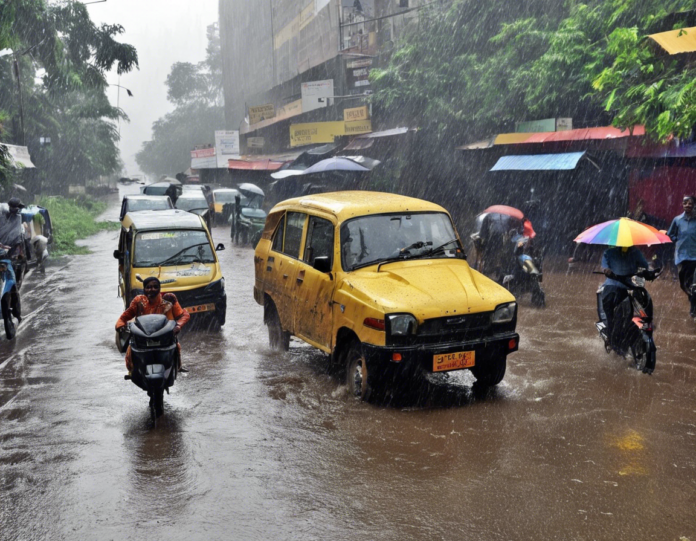The city of Mumbai is synonymous with heavy rains during the monsoon season. Every year, the monsoon brings with it a mix of relief and chaos for the residents of the city. While the rains are crucial for replenishing water sources and maintaining the ecological balance, they also pose significant challenges in terms of flooding, waterlogging, transportation disruptions, and health hazards.
Understanding Mumbai’s Monsoon
Mumbai experiences the Southwest Monsoon, which typically arrives in the city by early June and lasts until September. The city receives a substantial amount of rainfall during this period, with an average of over 2,000 mm of rainfall annually. The monsoon winds bring moisture-laden clouds from the Arabian Sea, resulting in heavy downpours across the city and its suburbs.
Impact of Monsoon on Mumbai
1. Flooding and Waterlogging: Mumbai’s low-lying areas are particularly vulnerable to flooding during heavy rains. The inadequate drainage system and encroachment of water bodies exacerbate the problem, leading to waterlogging in several parts of the city.
2. Transport Disruptions: The Mumbai local trains, known as the lifeline of the city, often face disruptions and delays due to waterlogging on tracks. Road traffic also comes to a standstill in many areas, causing inconvenience to commuters.
3. Health Concerns: The stagnant water during the monsoon becomes a breeding ground for mosquitoes, increasing the risk of vector-borne diseases such as dengue and malaria. Waterborne diseases are also prevalent during this time.
4. Infrastructure Challenges: Buildings and infrastructure in Mumbai are susceptible to damage from heavy rains, leading to issues such as leaks, seepage, and even building collapses in some extreme cases.
Tips to Stay Safe During Mumbai Monsoon
- Avoid wading through flooded streets to prevent waterborne illnesses.
- Use mosquito repellent to protect against mosquito bites.
- Stay updated on weather forecasts and traffic advisories.
- Keep emergency numbers handy in case of any untoward incidents.
- Ensure proper drainage around your home to prevent waterlogging.
Frequently Asked Questions (FAQs)
1. How much rain does Mumbai receive during the monsoon season?
Mumbai receives an average of over 2,000 mm of rainfall annually during the monsoon season.
2. What are the common challenges faced by Mumbai during monsoon?
Flooding, waterlogging, transport disruptions, health concerns, and infrastructure challenges are common issues faced by Mumbai during the monsoon.
3. How can residents stay safe during the monsoon in Mumbai?
Residents can stay safe by avoiding flooded areas, using mosquito repellent, staying updated on weather forecasts, keeping emergency numbers handy, and ensuring proper drainage around their homes.
4. Are there any tips to prevent waterborne diseases during the monsoon?
To prevent waterborne diseases during the monsoon, avoid consuming unfiltered water, maintain personal hygiene, and use clean water for daily activities.
5. How does the monsoon impact agriculture in the Mumbai region?
The monsoon is crucial for agriculture in the Mumbai region as it provides the necessary water for crops to grow. However, excessive rainfall can also lead to waterlogging and crop damage.
6. What should commuters do during heavy rains in Mumbai?
Commuters should stay updated on the status of local trains and road traffic, avoid unnecessary travel during heavy rains, and plan their routes in advance to avoid getting stuck in waterlogged areas.
7. How does the BMC (Brihanmumbai Municipal Corporation) prepare for the monsoon season?
The BMC undertakes pre-monsoon preparedness activities such as cleaning drains, desilting, and repairing infrastructure to mitigate the impact of heavy rains in Mumbai.
8. What are some monsoon safety tips for pets in Mumbai?
Ensure that your pets have a safe and dry shelter, keep them away from stagnant water, bathe them regularly to prevent skin infections, and consult a veterinarian if they show any signs of illness.
9. How can residents contribute to reducing flooding in their areas during the monsoon?
Residents can contribute by ensuring that garbage is disposed of properly, not encroaching on water bodies, clearing debris from drains, and adopting rainwater harvesting practices to prevent flooding in their areas.
10. How can tourists enjoy Mumbai during the monsoon season?
Tourists can explore indoor attractions such as museums, art galleries, and cafes, experience the local cuisine, attend cultural events, and take guided heritage walks to make the most of their visit to Mumbai during the monsoon season.
In conclusion, while the monsoon in Mumbai brings challenges, it also highlights the resilience and spirit of its residents in navigating through monsoon mayhem. By staying informed, prepared, and vigilant, both residents and authorities can work together to minimize the impact of heavy rains and make the most of this crucial season for the city.

